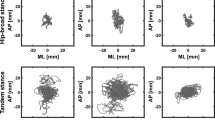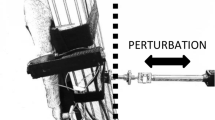Abstract
This study investigated the extent to which specific interacting constraints of performance might increase or decrease the emergent complexity in a movement system, and whether this could affect the relationship between observed movement variability and the central nervous system’s capacity to adapt to perturbations during balancing. Fifty-two healthy volunteers performed eight trials where different performance constraints were manipulated: task difficulty (three levels) and visual biofeedback conditions (with and without the center of pressure (COP) displacement and a target displayed). Balance performance was assessed using COP-based measures: mean velocity magnitude (MVM) and bivariate variable error (BVE). To assess the complexity of COP, fuzzy entropy (FE) and detrended fluctuation analysis (DFA) were computed. ANOVAs showed that MVM and BVE increased when task difficulty increased. During biofeedback conditions, individuals showed higher MVM but lower BVE at the easiest level of task difficulty. Overall, higher FE and lower DFA values were observed when biofeedback was available. On the other hand, FE reduced and DFA increased as difficulty level increased, in the presence of biofeedback. However, when biofeedback was not available, the opposite trend in FE and DFA values was observed. Regardless of changes to task constraints and the variable investigated, balance performance was positively related to complexity in every condition. Data revealed how specificity of task constraints can result in an increase or decrease in complexity emerging in a neurobiological system during balance performance.




Similar content being viewed by others
Notes
Sample entropy was also calculated as another entropy measure to assess the degree of irregularity of CoP values. To calculate this measure, we used the following parameter values: vector length, m = 2; tolerance window, r = 0.2 * SD (Pincus, 1991). The results were very similar to the FE results, in both the effect of the different constraints and the correlation between performance and complexity.
References
Barbado D, Sabido R, Vera-Garcia FJ, Gusi N, Moreno FJ (2012) Effect of increasing difficulty in standing balance tasks with visual feedback on postural sway and EMG: complexity and performance. Hum Mov Sci 31:1224–1237
Bashan A, Bartsch R, Kantelhardt JW, Havlin S (2008) Comparison of detrending methods for fluctuation analysis. Phys A 387:5080–5090
Borg FG, Laxaback G (2010) Entropy of balance: some recent results. J NeuroEng Rehabil 7:38. doi:10.1186/1743-0003-7-38
Caballero C, Barbado D, Moreno FJ (2013) El procesado del desplazamiento del centro de presiones para el estudio de la relación complejidad/rendimiento observada en el control postural en bipedestación. Rev Andal Med Deporte 6:101–107
Caballero C, Barbado D, Moreno FJ (2014) Non-linear tools and methodological concerns measuring human movement variability: an overview. Eur J Hum Mov 32:61–81
Cattaneo D, Carpinella I, Aprile I, Prosperini L, Montesano A, Jonsdottir J (2015) Comparison of upright balance in stroke, Parkinson and multiple sclerosis. Acta Neurol Scand. doi:10.1111/ane.12466
Chen Z, Ivanov PC, Hu K, Stanley HE (2002) Effect of nonstationarities on detrended fluctuation analysis. Phys Rev E 65:041107
Chen W, Wang Z, Xie H, Yu W (2007) Characterization of surface EMG signal based on fuzzy entropy. IEEE Trans Neural Syst Rehabil Eng 15:266–272
Chen W, Zhuang J, Yu W, Wang Z (2009) Measuring complexity using FuzzyEn, ApEn, and SampEn. Med Eng Phys 31:61–68. doi:10.1016/j.medengphy.2008.04.005
Costa M, Goldberger AL, Peng C-K (2002) Multiscale entropy analysis of complex physiologic time series. Phys Rev Lett 89:068102
Danna-Dos-Santos A, Degani AM, Zatsiorsky VM, Latash ML (2008) Is voluntary control of natural postural sway possible? J Mot Behav 40:179–185
Davids K, Kingsbury D, George K, O’Connell M, Stock D (1999) Interacting constraints and the emergence of postural behavior in ACL-deficient subjects. J Mot Behav 31:358–366
Davids K, Glazier P, Araujo D, Bartlett R (2003) Movement systems as dynamical systems: the functional role of variability and its implications for sports medicine. Sports Med 33:245–260
Davids K, Bennett S, Newell KM (2006) Movement system variability. Human kinetics, Champaign, USA
Decker LM, Cignetti F, Stergiou N (2010) Complexity and human gait. Rev Andal deMedicina del Deporte 3:2–12
Donker SF, Roerdink M, Greven AJ, Beek PJ (2007) Regularity of center-of-pressure trajectories depends on the amount of attention invested in postural control. Exp Brain Res 181:1–11
Duarte M, Sternad D (2008) Complexity of human postural control in young and older adults during prolonged standing. Exp Brain Res 191:265–276
Ferguson CJ (2009) An effect size primer: a guide for clinicians and researchers. Prof Psychol Res Pract 40:532–538
Goldberger AL, Amaral LAN, Hausdorff JM, Ivanov PC, Peng C-K, Stanley HE (2002a) Fractal dynamics in physiology: alterations with disease and aging. Proc Natl Acad Sci 99:2466–2472
Goldberger AL, Peng C-K, Lipsitz LA (2002b) What is physiologic complexity and how does it change with aging and disease? Neurobiol Aging 23:23–26
Hancock GR, Butler MS, Fischman MG (1995) On the problem of two-dimensional error scores: measures and analyses of accuracy, bias, and consistency. J Mot Behav 27:241–250
Herzfeld DJ, Shadmehr R (2014) Motor variability is not noise, but grist for the learning mill. Nat Neurosci 17:149–150. doi:10.1038/nn.3633
Hornero R, Aboy M, Abásolo D, McNames J, Goldstein B (2005) Interpretation of approximate entropy: analysis of intracranial pressure approximate entropy during acute intracranial hypertension. IEEE Trans Biomed Eng 52:1671–1680
Krakauer JW, Mazzoni P (2011) Human sensorimotor learning: adaptation, skill, and beyond. Curr Opin Neurobiol 21:636–644
Lake DE, Richman JS, Griffin MP, Moorman JR (2002) Sample entropy analysis of neonatal heart rate variability. Am J Physiol Regul Integr Comp Physiol 283:R789–R797
Lee H, Granata KP (2008) Process stationarity and reliability of trunk postural stability. Clin Biomech 23:735–742
Lin D, Seol H, Nussbaum MA, Madigan ML (2008) Reliability of COP-based postural sway measures and age-related differences. Gait Posture 28:337–342. doi:10.1016/j.gaitpost.2008.01.005
Lipsitz LA, Goldberger AL (1992) Loss of ‘complexity’ and aging. Potential applications of fractals and chaos theory to senescence. JAMA 267:1806–1809
Liu J, Zhang C, Zheng C (2010) EEG-based estimation of mental fatigue by using KPCA–HMM and complexity parameters. Biomed Signal Process Control 5:124–130
Manor B, Lipsitz LA (2013) Physiologic complexity and aging: implications for physical function and rehabilitation. Prog Neuropsychopharmacol Biol Psychiatry 45:287–293. doi:10.1016/j.pnpbp.2012.08.020
Manor B et al (2010) Physiological complexity and system adaptability: evidence from postural control dynamics of older adults. J Appl Physiol 109:1786–1791
Menayo R, Encarnación A, Gea G, Marcos P (2014) Sample entropy-based analysis of differential and traditional training effects on dynamic balance in healthy people. J Mot Behav 46:73–82
Mochizuki L, Duarte M, Amadio AC, Zatsiorsky VM, Latash ML (2006) Changes in postural sway and its fractions in conditions of postural instability. J Appl Biomech 22:51
Newell KM, Slifkin AB (1998) The nature of movement variability. In: Piek JP (ed) Motor behavior and human skill: a multidisciplinary perspective. Human Kinetics, Champaign, pp 143–160
Newell KM, Vaillancourt DE (2001) Dimensional change in motor learning. Hum Mov Sci 20:695–715
Peng CK, Havlin S, Stanley HE, Goldberger AL (1995) Quantification of scaling exponents and crossover phenomena in nonstationary heartbeat time series. Chaos Interdiscip J Nonlinear Sci 5:82–87
Prieto TE, Myklebust JB, Hoffmann RG, Lovett EG, Myklebust BM (1996) Measures of postural steadiness: differences between healthy young and elderly adults. IEEE Trans Biomed Eng 43:956–966
Renart A, Machens CK (2014) Variability in neural activity and behavior. Curr Opin Neurobiol 25:211–220. doi:10.1016/j.conb.2014.02.013
Rhea CK, Silver TA, Hong SL, Ryu JH, Studenka BE, Hughes CML, Haddad JM (2011) Noise and complexity in human postural control: interpreting the different estimations of entropy. PLoS One 6:e17696
Riley MA, Turvey MT (2002) Variability and determinism in motor behavior. J Mot Behav 34:99–125
Riley MA, Shockley K, Van Orden G (2012) Learning from the body about the mind. Top Cogn Sci 4:21–34. doi:10.1111/j.1756-8765.2011.01163.x
Roerdink M, De Haart M, Daffertshofer A, Donker S, Geurts A, Beek P (2006) Dynamical structure of center-of-pressure trajectories in patients recovering from stroke. Exp Brain Res 174:256–269
Roerdink M, Hlavackova P, Vuillerme N (2011) Center-of-pressure regularity as a marker for attentional investment in postural control: a comparison between sitting and standing postures. Hum Mov Sci 30:203–212. doi:10.1016/j.humov.2010.04.005
Schmit JM, Riley MA, Dalvi A, Sahay A, Shear PK, Shockley KD, Pun RY (2006) Deterministic center of pressure patterns characterize postural instability in Parkinson’s disease. Exp Brain Res 168:357–367
Smith BA, Teulier C, Sansom J, Stergiou N, Ulrich BD (2011) Approximate entropy values demonstrate impaired neuromotor control of spontaneous leg activity in infants with myelomeningocele. Pediatric Phys Ther 23:241
Stergiou N, Harbourne RT, Cavanaugh JT (2006) Optimal movement variability: a new theoretical perspective for neurologic physical therapy. J Neurol Phys Ther 30:120–129
Tahayori B, Riley ZA, Mahmoudian A, Koceja DM, Hong SL (2012) Rambling and trembling in response to body loading. Mot Control 16:144–157
Vaillancourt DE, Newell KM (2002) Changing complexity in human behavior and physiology through aging and disease. Neurobiol Aging 23:1–11
Vaillancourt DE, Newell KM (2003) Aging and the time and frequency structure of force output variability. J Appl Physiol 94:903–912
Vaillancourt DE, Sosnoff JJ, Newell KM (2004) Age-related changes in complexity depend on task dynamics. J Appl Physiol (1985) 97:454–455. doi:10.1152/japplphysiol.00244.2004
van Dieën JH, Koppes LLJ, Twisk JWR (2010) Postural sway parameters in seated balancing; their reliability and relationship with balancing performance. Gait Posture 31:42–46
van Emmerik REA, van Wegen EEH (2000) On variability and stability in human movement. J Appl Biomech 16:394–406
Wilkins BA, Komanduri R, Bukkapatnam S, Yang H, Warta G, Benjamin BA (2009) Recurrence quantification analysis (RQA) used for detection of ST segment deviation. FASEB J 23:LB89
Xie H-B, Guo J-Y, Zheng Y-P (2010) Fuzzy approximate entropy analysis of chaotic and natural complex systems: detecting muscle fatigue using electromyography signals. Ann Biomed Eng 38:1483–1496
Zatsiorsky VM, Duarte M (1999) Instant equilibrium point and its migration in standing tasks: rambling and trembling components of the stabilogram. Mot Control 3:28–38
Acknowledgments
This study was made possible by financial support from Science and Innovation Ministry of Spain, Project Cod. DEP2010-19420 and Project Cod. FPU12/00659. Spanish Government.
Author information
Authors and Affiliations
Corresponding author
Ethics declarations
Conflict of interest
This is to inform you that there are no conflicts of interest that could inappropriately influence (bias) this work.
Rights and permissions
About this article
Cite this article
Caballero Sánchez, C., Barbado Murillo, D., Davids, K. et al. Variations in task constraints shape emergent performance outcomes and complexity levels in balancing. Exp Brain Res 234, 1611–1622 (2016). https://doi.org/10.1007/s00221-016-4563-2
Received:
Accepted:
Published:
Issue Date:
DOI: https://doi.org/10.1007/s00221-016-4563-2




